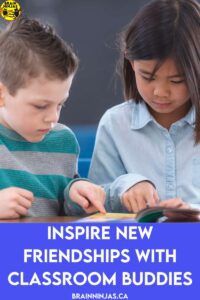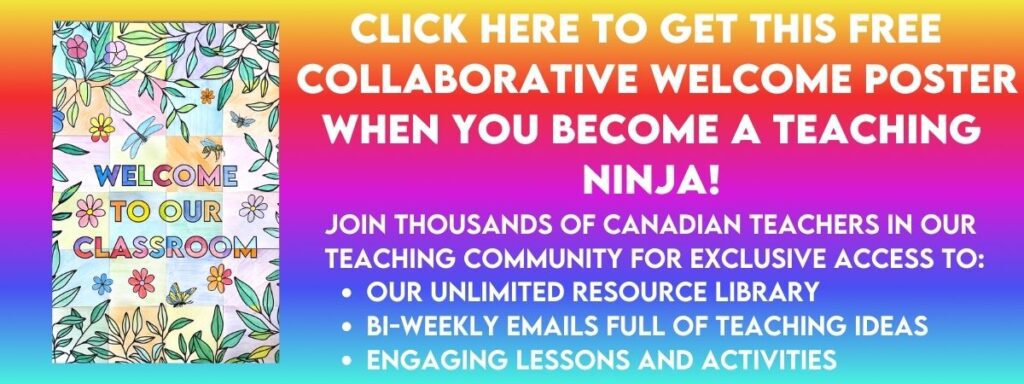
One of the most rewarding aspects of teaching is fostering positive relationships between students. A powerful way to do this is through cross-age buddy programs. Pairing older students with younger students can create lasting friendships, enhance social-emotional skills, and promote academic growth. Buddy teachers can also become life-long friends. Come learn the benefits and collect these ideas to add to your classroom buddy time.
What Are the Benefits of Cross-Age Buddies?
Cross-age buddies refer to a group of older students paired with younger students. This can also be high school or older age with elementary or middle school groups. One of our favourite pairings was a grade five class with members of the senior community centre near our school. There’s more on that story later.
Older students can model positive social behaviours, such as sharing, cooperation, and empathy, for younger students. This can be helpful for learning social skills and developing social-emotional learning.
Younger students often look up to older students, and positive interactions can boost their self-esteem for both parties. Even older students who struggle with behaviour in their own class can become good role models and shine in a buddy situation.

Older students can serve as tutors or study buddies, helping younger students to improve their academic skills. This can include mentoring, peer teaching, or even just boosting confidence.
Cross-age buddy programs can create a stronger sense of community within the school. These friendships can carry on from year to year. Nothing is cuter than seeing last year’s buddies find their older friend in the hallway during back to school.
Older students can develop leadership skills by mentoring younger students. They can create activities for their buddy groups and foster a love of service.
Older students can learn to adjust their tone and language for the younger audience without talking down to them.
Younger students have an ally on the playground in case there’s a problem. The older buddy can feel empowered to be helpful.
Choosing Buddies

Pairing up students with buddies can be a challenge if you don’t know the students well.
First, both groups should be around the same size. While you can occasionally have a group of three, pairs work best. If you have any chronically absent students, put these in a group of three because then there is more likely to be a pair.
The teacher with the younger students may have taught the older students, so use their input. Grab a class list for each group and write out the buddies. We recommend typing this out on a slide that you can project whenever you are together. This is especially helpful as the buddies begin to get to know each other.
We also teach our students that when we get together, if their buddy is not present, stand at the front board. These are called “bonus buddies” when their partner is away. We use the bonus buddies to pair students up for the day.
Easy Buddy Activities You Should Try
Some of these are tried and true activities that you can do any time of year. Never underestimate the time spent with your buddies, but it doesn’t need to be complicated or elaborate.
Reading
Older students can read to younger students, fostering a love of reading and language skills. They can curl up with a good book. Younger students can also read to their older buddies to help practice their reading skills.
Teach the older buddies not to “teach” reading. If the buddy needs help with a word, just give them the word. If they make a mistake, say, “Did that sound right? I think it was…” The reading time should just be for the love of reading.
Instead of reading to each other, the buddies can pair read. This means they read the text together at the same time. It’s a great way to help scaffold reading. If you have an older student struggling in reading, they can be the leader in a lower-level text by making them feel like the younger student is the one needing the help.
The teachers can use this time to eavesdrop on students to hear their reading without “assessing,” so use the time.
Art Projects

Collaborative art projects can encourage creativity and teamwork. Older students can help with cutting, gluing, or just keeping all the pieces together. Remind your older students to let the younger ones do the projects without too much influence. It’s always fun to see what students come up with when they work together.
We have several blog posts full of different projects. These projects were written for upper elementary students, but many can be done with the help of older buddies.
- How to Create Fingerprint Art Projects
- Save Time With this Christmas Art Collection
- Heart Art Projects You’ll Love
Create a Collaborative Poster Together
Our collaborative posters come in 18, 24, or 36 pieces. Students colour their pieces, and then all the pieces are assembled into a poster. Older students can help the younger buddies colour their pieces and cut them out. They can also help assemble the poster.
These are some of our favourite posters that work well.
- Working Together Collaborative Poster on TpT ($USD) or our BN Shop ($CAN)
- Be the Sunshine Collaborative Poster on TpT ($USD) or our BN Shop ($CAN)
- Spring Collaborative Poster on TpT ($USD) or our BN Shop ($CAN)
- We’re So Sweet Collaborative Poster on TpT ($USD) or our BN Shop ($CAN)
- Seven Teachings Collaborative Poster on TpT ($USD) or our BN Shop ($CAN)
We’ll send this Welcome to Our Classroom Poster when you sign up for our email list. If you’re already on the list, you can find it in our Resource Library. It is also available in French.
Games and Puzzles
Board games, card games, and puzzles can help develop problem-solving and strategic thinking skills. Playing a simple game like Go Fish can help students practice numbers. A board game helps students learn to take turns. Jigsaw puzzles help students look at shapes and colours.
Outdoor Play
Shared outdoor activities, such as tag, hopscotch, or nature walks, can promote physical activity and social interaction. Older students love to go to the playground at our school because they aren’t allowed on it during recess breaks (too many littles and not enough playground).
Take a short walk to a nearby park with a playground. The novelty of the newer playground can be a lot of fun. The walk and fresh air are great for everyone, but the older students can help wrangle the littles and keep them out of harm’s way.
Music and Movement

Singing songs, playing instruments, or dancing together can be a fun and engaging activity. Your school’s music teacher can teach both classes the same songs so they can sing them together.
Simple nursery songs are great for this. The rhyming helps students with reading (yes, actual reading), while the movement helps students with gross and fine motor skills. There are lots of nursery rhyme songs online to use for a start.
Have the older students learn the songs and then teach them to the younger students. Bring everyone together for a simple performance.
Help younger students make drums out of recycled food containers and really put on a show.
Community Service Projects
Working together on community service projects can instill a sense of civic responsibility. Older students can help with the organizing, while younger students can participate.
Over the years, we have done lots of different service projects in our community. This can be as simple as the older students escorting younger students during a Terry Fox Run. They can collect food for the local food bank.
Letter Writing
Older students can write letters or draw pictures for younger students, sharing words of encouragement and friendship. Younger students can do the same. They can send Christmas cards or valentines to each other.
The writing doesn’t need to be a letter. There are lots of things older buddies can help write. They can scribe stories, write sentences to describe a science project, make a list of the steps taken by the younger buddy to complete a project, or write a card to someone they love.
A Quick Buddy Story
One of our all-time favourite buddy groups was our grade five class with the seniors at the community centre just down the road from our school. We were learning about life during the Great Depression as part of our social studies lessons. The seniors were learning about the internet.
So, we paired up seniors with our students. The seniors described their childhoods and were interviewed by the students. The students taught the seniors how to get online and send an email. The school emails were used, so there was nothing to worry about security-wise, and all the emails were kept public in our classroom.
Then, we visited and emailed for the rest of the school year. The seniors attended our assemblies and concerts. We visited their centre to learn all kinds of things. Students were knitting and baking. Some of the seniors started volunteering at the school. They helped with school events and listening to students read. Our students were so much more aware of the community and the people in it.
Never underestimate the benefits of cross-age groups. They can be very powerful.
Do You Teach in Elementary School?
We have these blog posts that you might find helpful. Some of them also have ideas that you could adapt into buddy activities.
- Quiet Classroom Games You’ll Love
- 7 Fantastic Ways to Create Classroom Community
- 9 Quick Games to Teach Your Students
Do you have a favourite activity you do with your classroom buddies? We’d love to hear about it. Let us know in the comments below.







